Bettas are some of the most popular types of fish known for their vibrant coloration patterns and long, flowing fins. Halfmoon bettas are among the most striking, with fins that spread out to a 180-degree angle and brilliantly colored bodies.
If you’re thinking of adding a Halfmoon betta to your home aquarium, there’s a few things you should know first. In this guide, we’ll cover everything from betta lifespan and diet to housing and breeding tips. By the end, you’ll be an expert on everything Halfmoon bettas!
Characteristics/Appearance/LifeSpan
Common Name (species)
Halfmoon Betta Fish, Siamese Fighting Fish (Generic)
Family
Osphronemidae
Origin
Southeast Asia
Diet
Omnivore
Care Level
Easy
Activity
Active, social, alert
Temperament
Aggressive
Tank Level
Top
Minimum Tank Size
5 Gallons
Temperature Range
72 – 80 degrees Fahrenheit
Water Hardness
5 – 20 dH
pH Range
6.5 – 7.5
Filtration/Flow Rate
Calm
Breeding
Egg layer
Compatibility
Similarly-sized community fish
OK, for Planted Tanks?
Yes, but make sure the plants do not have jagged edges.
What Do Halfmoon Betta Fish Look Like?
Halfmoon bettas are a type of betta fish with distinct tails that spread out to a 180-degree angle. These rounded tails are often described as looking like half-moons, hence the name. Among the many different designer tail types, Halfmoon bettas have a tail shape that is one of the most popular and easily recognizable.
Apart from their tail shape, Halfmoon bettas are also known for their brilliantly colored bodies. These fish come in a wide variety of typical betta fish colors – and then some. Their fins come in bright colors, and may also be patterned or solid-colored. Some Halfmoon bettas even have marbleized patterns on their bodies!
In terms of size, Halfmoon bettas typically grow to be about 2.5 inches long. They have a rather typical body type as far as aquarium fish go, with a long, slender body and a small head. However, they have a slightly downturned mouth, which gives them a permanent “frowning” expression. Don’t let this discourage you, though – Halfmoon bettas are actually quite lovely fish to keep as pets!
How Long Do Halfmoon Betta Fish Live?
The average lifespan of a Halfmoon betta fish is 3 years, although some have been known to live up to 5 years with proper care. However, it’s important to keep in mind that bettas – including Halfmoon bettas – are quite delicate fish. As such, it’s not uncommon for them to succumb to disease or other health problems long before they reach their maximum lifespan.
To help your Halfmoon betta live a long and healthy life, it’s important to provide them with proper care. This includes everything from maintaining clean water conditions to feeding them a nutritious diet. We’ll cover all of this and more in the sections below!
Temperament and Tankmates
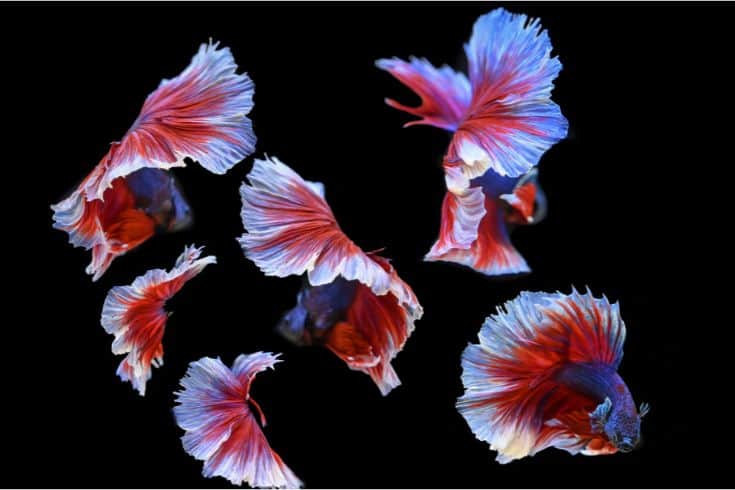
It’s hard to divorce any discussion of Halfmoon bettas because they are, first and foremost, fighting fish. Bettas have been bred for centuries to fight one another in bloodsport, and as such, they have a reputation for being aggressive, dominant fish. Because their reputation precedes them, many halfmoon bettas live out their lives as solitary fish – but this doesn’t have to be the case!
With proper care and a little bit of patience, Halfmoon bettas can make excellent tankmates to other freshwater fish that are calm and non-aggressive. Similarly-sized community fish are a good choice, as long as they’re not too nippy or rowdy. Be sure to keep an eye on your fish, though, as you want to be prepared in the event that a fish fight breaks out.
When it comes to temperament, Halfmoon bettas can be a bit hit-or-miss. Some are relatively docile and easygoing, while others can be rather feisty and aggressive. There’s really no way to know which temperament your Halfmoon betta will have until you get to know them, so it’s important to be prepared for either possibility.
What Do Halfmoon Bettas Eat?
Now that we know a little bit about what Halfmoon bettas look like and how to care for them, it’s time to talk about one of the most important aspects of betta care: diet.
Bettas are carnivorous fish, which means that they require a diet that is rich in protein. In the wild, bettas feed primarily on small insects and other invertebrates. However, in captivity, it’s often not realistic or practical to have a constant supply of live food on hand. As such, most bettas are fed a diet of freeze-dried, pelletized, or flaked fish feed from pet stores.

In addition to a diet of commercial fish food, Halfmoon bettas will also benefit from the occasional treat of live or frozen food. Bloodworms, baby brine shrimp, and daphnia are all good choices and will ensure that your betta meets its nutritional needs from a wide range of sources.
Proper nutrition is essential for maintaining a healthy immune system, so don’t skimp on the food!
Do Bettas Need Supplements?
Many believe that bettas need to be supplemented with vitamins and minerals to stay healthy and have brighter colors. Is this really necessary?
The short answer is no, bettas do not need to be supplemented with vitamins or minerals. Bettas are native to nutrient-rich waters in Southeast Asia, and as such, they are used to getting all of the nutrients they need from their natural environment. In captivity, bettas will get all the nutrients they need from a high-quality commercial fish food.

That said, there is one possible exception to this rule: if you are keeping your betta in a very small tank (less than 5 gallons), it is possible that the water might not have enough dissolved oxygen and nutrients to support your betta’s needs. In this case, you might consider supplementing with a product like API’s Bettafix. This product contains essential vitamins and minerals that can help to ensure your betta’s health and vitality.
The allure of vibrant colors and good health is tempting, but be careful not to overdo it with supplements. Bettas are very sensitive to fluctuations in water quality, and too many supplements can easily create toxic water conditions for your fish. When in doubt, it’s always best to avoid caution and stick to a simple diet of high-quality commercial fish food.
Feeding Frequency – How Do You Prevent Overfeeding?
One common issue that betta owners face is overfeeding. Bettas have small stomachs, and as such, they don’t need to eat all that much. Overfeeding can lead to a whole host of problems, including obesity, swim bladder disease, and even organ damage.
To avoid overfeeding your Halfmoon betta, it’s best to stick to a feeding schedule of 2-3 times per day, and to only offer as much food as your betta can eat in 2-3 minutes. It’s also a good idea to fast your betta one day per week to allow their digestive system a chance to rest.
Habitat Requirements
Now that we’ve covered diet and feeding frequency, it’s time to talk about tank size. The aquarium habitats that bettas are typically sold in (i.e., those tiny plastic bowls) are woefully inadequate for long-term care. Not only are they too small, but they also lack the filtration and aeration that bettas need to stay healthy.
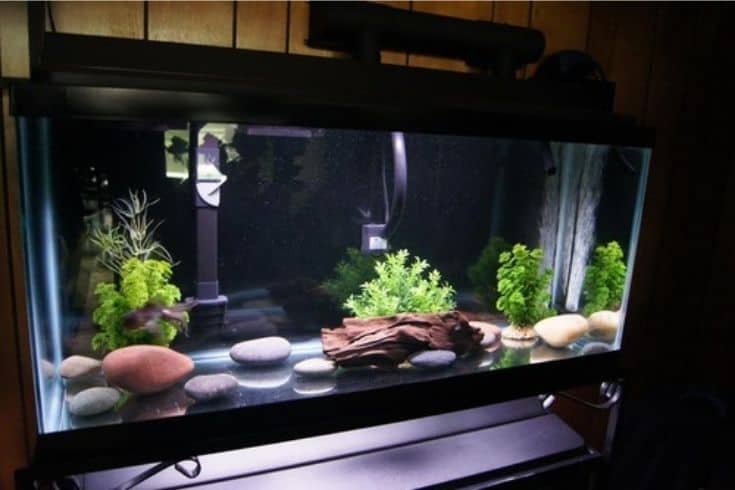
To keep your Halfmoon betta healthy and happy, you’ll need to provide them with a minimum tank size of 2.5 gallons. Let’s take a look at some other important habitat requirements:
Water Conditions
Bettas are tropical fish, and as such, they need warm water to thrive. The ideal water temperature for bettas is 77-82 degrees Fahrenheit. If you live in a cooler climate, you’ll need to invest in a water heater to maintain these temperatures. Cold water can lead to a number of health problems in bettas, including stress, illness, and even death, so it’s important to get the temperature right.
In addition to being warm, you’ll need to keep water parameters ideal for bettas. Bettas thrive in soft water with a neutral pH but can also tolerate slightly harder water with a slightly higher pH (up to about 7.5). It’s best to use an aquarium water testing kit with a basic water conditioner to get your tank water right.
Poor water quality is one of the leading causes of death in betta fish, so it’s important to make sure that your tank is properly filtered and cycled. Steer clear of using colder water than is necessary, and be sure to test your water quality regularly.
Tank Maintenance
It’s no secret that bettas housed in dirty water have a shorter life expectancy. A halfmoon betta’s lifespan can be drastically increased simply by providing them with a clean and well-maintained habitat. Here are some tips to help you keep your tank clean:
- Use a high-quality filter designed for betta tanks. A good rule of thumb is to choose a filter that turns over the entire volume of your tank at least 3-4 times per hour.
- Perform partial to complete water changes on a weekly basis. This is a vital component of proper care, and will help to keep your betta’s water quality high.
- Don’t forget to clean the gravel and decorations regularly. Over time, these can become covered in algae and other debris, impacting water quality and leading to illness.
A well-maintained tanks allow your betta’s vivid colors to really shine through, and it also provides them with a stress-free environment in which they can thrive. Their activity levels will be higher, and they’ll be less susceptible to disease.
Plants and Decorations
Half-moon bettas live among dense vegetation in rice paddies, marshes, and slow-moving streams in their natural habitat. As such, they do best in tanks that closely mimic their natural environment.
To recreate their natural habitat, you’ll need to choose the right plants and decorations. Live aquatic plants are always best, but silk plants are the next best thing if you can’t get your hands on any. Be sure to source your plants from reputable aquarium supply stores, as they should be free of harmful chemicals and pesticides.
As for decorations, try to choose smooth items that won’t tear your betta’s fins. Driftwood, smooth rocks, and ceramic caves make good choices. A key component of basic betta fish care is providing your fish with a hiding place, which will help reduce stress levels.
Bettas are known for their love of exploring, so don’t be afraid to get creative with your tank setup. Just be sure to avoid using any sharp objects or decorations that could injure your fish!
Common Health Issues
Unfortunately, halfmoon bettas are prone to a number of health problems. The good news is that many of these problems can be avoided with proper care, and many can be treated if they do occur. Here are some of the most common health problems faced by halfmoon bettas:
Swim Bladder Disorder
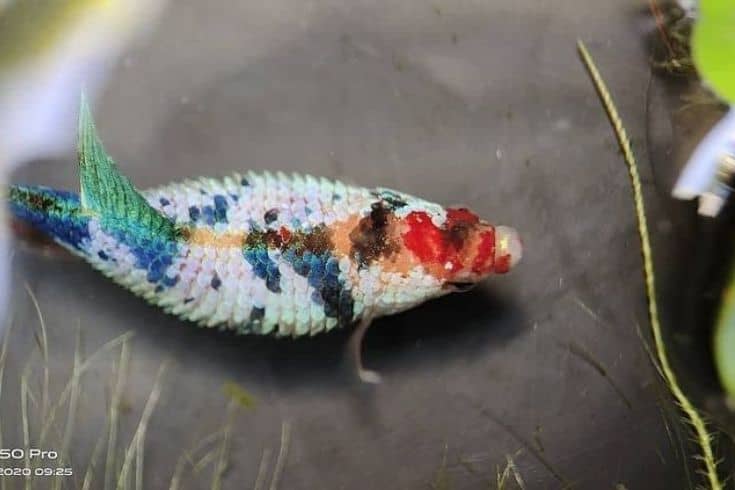
Swim bladder disorders in fish are caused by a number of factors, including poor diet, constipation, and infections. Symptoms include difficulty swimming, floating at the water’s surface, and an increased need to rest on the bottom of the tank.
If your betta is showing signs of swim bladder disorder, the best course of action is to take them to the vet for diagnosis and treatment. In some cases, changing the betta’s diet or providing them with more frequent water changes can help to resolve the problem.
Fungal Infections
Fungal infections are common in pet betta fish, and can be caused by a number of factors, including poor water quality, stress, and injuries. Symptoms include white or fuzzy patches on the skin, fins, or mouth.
Because fungal infections can be contagious, treating them as soon as possible is important. Isolate your betta in a hospital tank and treat the water with an anti-fungal medication. You can also treat your betta’s skin with an anti-fungal cream.
Bacterial Infections
Bacterial infections are exceptionally common in stressed-out bettas that are kept in poor water conditions. Symptoms include red or inflamed skin, fins, and mouth; cloudy eyes; and a loss of appetite. The difference between healthy betta fish and sick betta fish is often very subtle, so it’s important to keep a close eye on your fish.
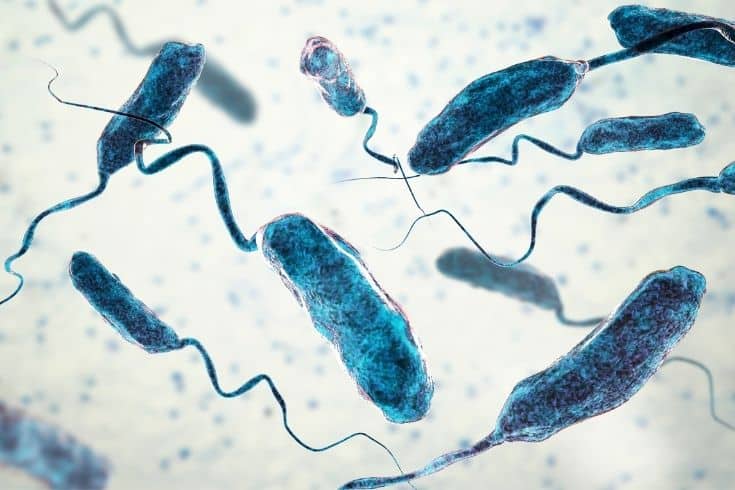
If you suspect that your betta has a bacterial infection, the best thing to do is to take them to the vet for diagnosis and treatment. In most cases, antibiotics will be required to clear the infection.
Fin Rot
Fin rot is a bacterial infection that causes the fins and tail to deteriorate. It’s often caused by poor water quality, but can also result from physical injuries or aggression from other fish. Symptoms include fraying or discoloration of the fins, and in severe cases, the fins may fall off entirely.
Because there are multiple root causes of fin rot, it’s important to seek professional help in order to properly diagnose and treat the problem. However, salt baths suffice as a preliminary treatment for most bettas.
Parasitic Infections
Last but not least, parasitic infections are also common in betta fish. The most common type of parasite is the velvet worm, which causes the skin to become irritated and discolored. Left untreated, parasitic infections can cause serious health problems, and in some cases, they can be fatal.
In most cases, parasitic infections can be treated with medication. You may need to consult a vet in order to get the correct diagnosis and prescription, but in many cases, you can treat the problem at home.
Prevention Trumps Cure
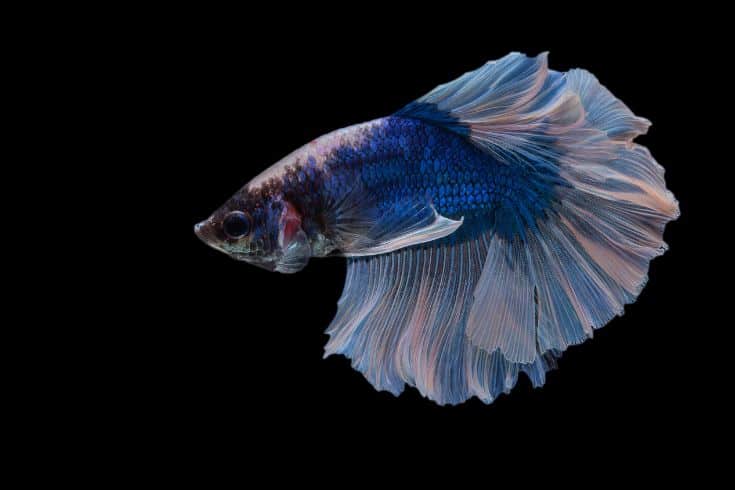
As they say, prevention is better than cure. The best way to keep your halfmoon betta healthy is to provide them with good quality water and a healthy diet. Be sure to do regular water changes, and don’t forget to clean the gravel and filter media. A little bit of effort on your part will go a long way in keeping your betta happy and healthy for years to come!
Breeding Your Halfmoon Betta
Halfmoon bettas are very popular among fishkeepers, so they command a high price tag. Professionals have perfected the selective breeding process to maximize their chance of success, but even so, halfmoon bettas can be tricky to breed.
If you’re planning on breeding your own halfmoon bettas, you must create a breeding tank first. This tank should be at least 10 gallons in size and equipped with a filter and heater. The water should be clean and well-oxygenated.
When selecting a breeding pair, it’s important to choose healthy and good-quality fish. The male should create good-sized bubble nests, as this is usually the biggest determinant of bubble nest quality. During the bubble nest phase, you should also look for a female fish with a white spot on her belly, known as the egg spot.
When the male is ready to breed, he will chase the female and try to entice her to release her eggs. Once she does, he will scoop them up in his mouth and spit them into the bubble nest. Within a few days, the eggs should hatch, and the fry will start to grow!
Of course, this is just a brief overview of the breeding process. If you’re interested in learning more, plenty of resources are available online.
Halfmoon Betta Fish Tank Requirements
After your halfmoon betta fish have been successfully bred, you’ll need to provide them with a suitable home. Here’s what this entails:
An Appropriate Tank Size
Halfmoon bettas are active fish that require adequate space to swim and explore. As a result, they should be kept in a ten-gallon tank, or something larger. A larger tank will not only provide your fish with more ample space to swim, but it will also result in fewer water quality issues. Plus, a larger tank will be necessary if you intend to house other fish with your halfmoon bettas.
In selecting the right aquarium sizes for your halfmoon bettas, it is also important to consider the quality of aquarium life support systems like aeration, filtration, and lighting. If these are of poorer quality, a larger tank will be necessary to maintain water quality. On the other hand, if you have a high-quality aquarium setup, you may be able to get away with a smaller tank.
Proper Filtration
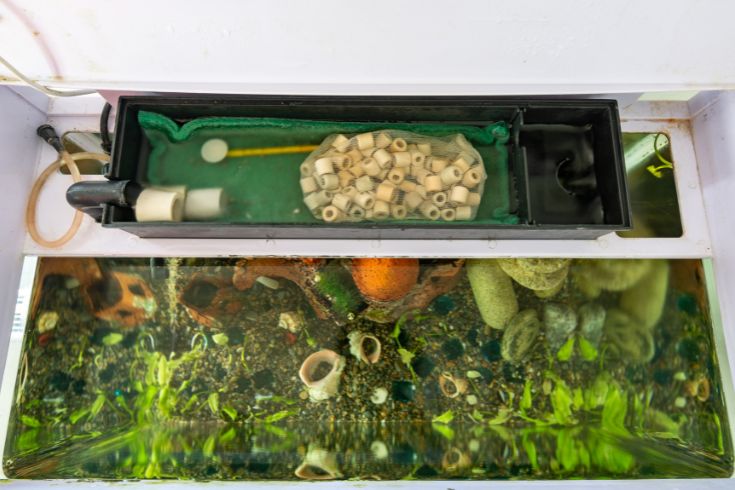
Speaking of filtration, it is absolutely essential to provide your halfmoon bettas with a good quality filter. A poor filtration system will quickly lead to water quality issues, which can put your fish at risk for several health problems.
There are a few different types of filters available on the market, but the most important thing is to choose one that is appropriate for the size of your tank. Hang-on-back filters are a good option for smaller tanks, as they will clean water without taking up a lot of space. Canister filters are also a good option and offer more features than hang-on-back filters.
Aeration Systems
Bettas are air-breathing fish that require a steady supply of oxygen. In the wild, they accomplish this by rising to the surface to gulp air, but in captivity, they rely on aeration systems to provide them with the oxygen they need.
Aeration can be accomplished in a number of different ways, but the most popular option is to use an air pump. This will pump air into the tank, which will disperse an air stone. Be sure to choose something that will maintain calm water movement, as strong currents can stress out your fish.
What Else Do You Need For A Betta Tank? Product Recommendations
In addition to the items mentioned above, you’ll need a few other things to set up a proper home for your halfmoon bettas. These include:
- Aquarium gravel: This will serve as the substrate for your tank and help keep the water clean. Be sure to choose something that is safe for bettas, such as the Fluval Aquarium Gravel.
- Heaters: Halfmoon bettas are tropical fish that require warm water to thrive. As a result, you’ll need to provide them with a heater. The Marina submersible heater is a good option.
- Water conditioners: It is also important to use a water conditioner to remove toxins from the water. This is especially important if you’re using tap water, as it may contain chemicals that can harm your fish. The Seachem Prime Water Conditioner is a good option.
- Books: If you’re new to keeping fish, investing in a good quality book on the subject is a good idea. This will help you to learn about the proper care and maintenance of your halfmoon bettas. The Betta Handbook by Robert J. Goldstein is a good option.
Now that you have all of the necessary supplies, it’s time to set up your halfmoon betta tank!
Halfmoon Betta Tank Setup
The first thing you’ll need to do is choose the location for your tank. It should be placed in a quiet area away from direct sunlight and drafts.
Once you’ve chosen the perfect location, it’s time to start setting up your tank! Begin by adding the gravel to the bottom of the tank. Next, add the water and then the water conditioners. Be sure to follow the manufacturer’s instructions carefully.
Now it’s time to add the plants and decorations. Be sure to choose items that are safe for bettas and that will not tear their fins. Once you’ve added the plants and decorations, you can start cycling the tank. This process can take up to a month, so be patient!
After the tank has been cycled, it’s time to add your halfmoon betta! Be sure to acclimate him to the new water slowly by adding a small amount of water from the tank to his bowl every hour for several hours. Once he’s acclimated, he can be released into the tank.
The Takeaway
Now that you know everything there is to know about halfmoon bettas, it’s time to put your knowledge to the test! We hope this guide has been helpful and that you’re now ready to start your own halfmoon betta tank. Thanks for reading!
